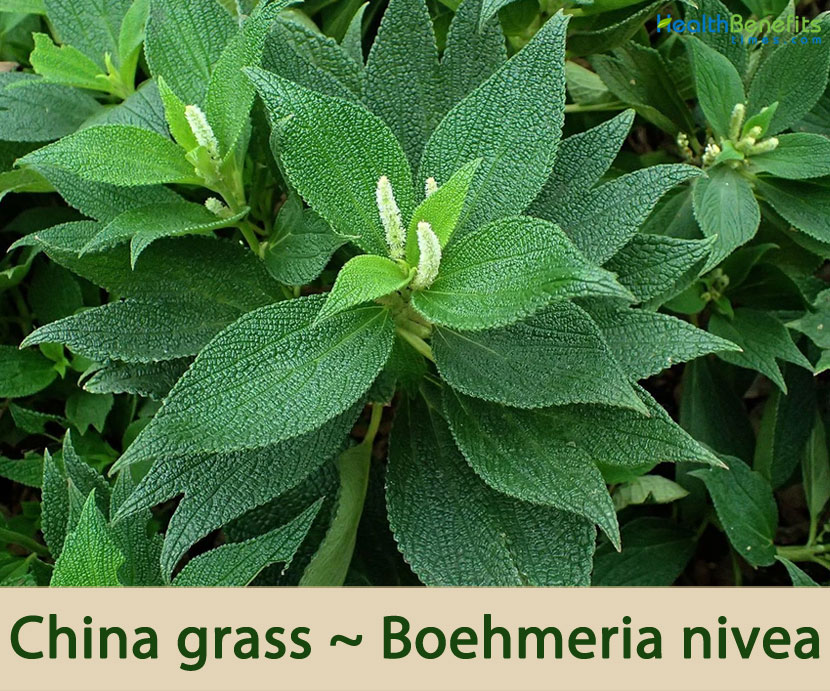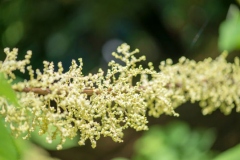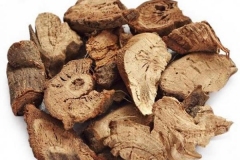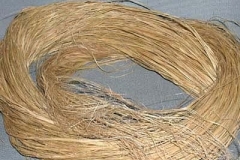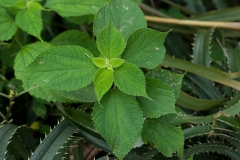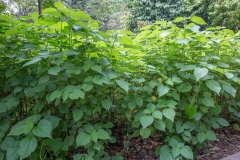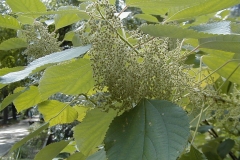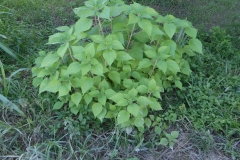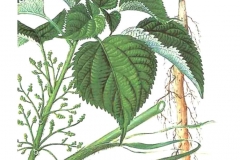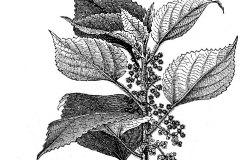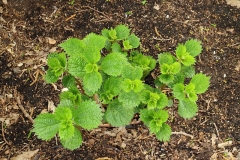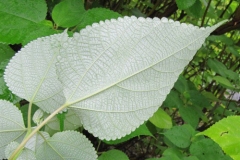Genus name honors George Rudolf Boehmer (1723-1803), professor of botany and anatomy at Wittenberg, Germany. Specific epithet means snow-white in probable reference to the underside of the leaves. It is harvested from the wild for local use as a food and also for medicinal use. It is highly cultivated for its high quality fiber or as an ornamental plant. It is also used in preventing miscarriages during pregnancy. The leaves are used as treatment of fluxes and wounds while the roots are used in the treatment of threatened abortions, colic of pregnancy, hemorrhoids, leucorrhoea, impetigo, etc. The root is edible when peeled and boiled. It has a pleasant and sweet taste. The leaves are furthermore used in making cakes. Ramie is planted to prevent soil erosion. The inner bark is a source of the known longest fiber used in making paper.
China Grass Facts
| China grass Quick Facts | |
|---|---|
| Name: | China grass |
| Scientific Name: | Boehmeria nivea |
| Origin | Southern China to the Himalayas of Bhutan, Sikkim and Nepal, but is now cultivated in a number of tropical to subtropical climates around the world, including parts of the southeastern U.S. and California |
| Colors | Brown-yellow |
| Shapes | Sub globose to ovoid achene about 1 mm in diameter, enclosed by the persistent perianth, hairy, crustaceous |
| Taste | Sweet, bitter |
| Health benefits | Beneficial for vaginal bleeding, threatened abortion, dysfunctional uterine bleeding, gastrointestinal bleeding, piles, rheumatism, leprosy, skin diseases, hemorrhoids and leucorrhoea |
| Name | China grass |
|---|---|
| Scientific Name | Boehmeria nivea |
| Native | Originated in southern China to the Himalayas of Bhutan, Sikkim and Nepal, but is now cultivated in a number of tropical to subtropical climates around the world, including parts of the southeastern U.S. and California |
| Common Names | Ramie, China-grass, Chinese grass, Chinese silkplant, Rhea-fibre, White ramie, Rhea, false nettle, Ramie blanche, zhu ma, ramie de Chine, namban kara mushi, rami, ortiga blanca, ramio |
| Name in Other Languages | Afrikaans: Aramide Albanian: Rami Amharic: Rami (ራሚ) Arabic: Rami (رامي), abyad (أبيض) Armenian: Rrami (ռամի) Assamese: Remi, Riha Azerbaijani: Ramie, Qar bemeriyası Basque: Rami Belarusian: Rami bielaje (Рамі белае) Bengali: Rāmiẏēra (রামিয়ের) Bulgarian: Ramiya (рамия) Burmese: Ray me (ရေမီ) Cambodia: Thmey Catalan: Rami Chamorro: Amahadyan, sayafi Chinese: Má (麻), Zhu ma (苎 麻 ), Níngmá (苧麻), Zhu ma Gen Croatian: Rami, Ramija Czech: Ramie, ramie sněhobílá, Urtica nivea Danish: Ramie Dutch: Ramee, Chinese rami, Ramie, Chinese ramie, English: Ramie, China-grass, Chinese grass, Chinese silkplant, Rhea-fibre, White ramie, Rhea, false nettle Esperanto: Rami Estonian: Ramjee Filipino: Ramie Finnish: Ramikuitu, rami French: Ramie, Ramie de Chine, ramie blanche Georgian: Rami (რამი), tetri rami (თეთრი რამი) German: Ramie, China-Nessel Greek: Rami (ραμί) Gujarati: Rēmī (રેમી) Hausa: Ramie Hebrew: ראמי, סרפד Hindi: Ek prakaar ka paudha (एक प्रकार का पौधा), raimee (रैमी), Rheea, Inan, Puya Kuukhoora, Pan Hungarian: Hócsalán Icelandic: Ramie, Ramí Ido: Ramio Indonesian: Rami, haramay, kelui, Gambe, Kalooee, Rami, Haramay Irish: Ramie Italian: Ramiè, Ortica argentata, ramia Japanese: Ramī (ラミー), Kara mushi (カラムシ), Nanba nkaramushi (ナンバ ンカラムシ), Tajo karao, Mao, Kusa-mao Javanese: Ramie, Rami Kannada: Rāmi (ರಾಮಿ), Kittanāru (ಕಿತ್ತನಾರು) Kazakh: Ramy (рами) Korean: Lami (라미), mosipul (모시풀) Kurdish: Ramie Lao: Ramie, pan, po pan Latin: Ramie Latvian: Rāmijs Lithuanian: Ramunė, Pluoštinė bemerija Macedonian: Ramy (Рами) Malagasy: Ramie Malay: Ramie Malayalam: Rāmi (റാമി) Malaysia: Ramee, Rami, Rami-rami Maltese: Rami Marathi: Rĕmī (रॅमी) Mongolian: Ramy (рами) Myanmar: Goun Nepali: Ramee (रमी) Netherlands: Rameh plant Norwegian: Rami, Kinagras, Ramie Oriya: ରାମି Palauan: Rami Pashto: Rami (رامي) Persian: رامی, رامی Philippines: Amirai, arimai, labnis Polish: Rami, Szczmiel bialy Portuguese: Rami, Ramie, ramie-de-China, seda-vegetal Punjabi: Ramie Romanian: Ramiă Russian: Ramy (рами), Rami (Рами), rami beloye (рами белое), beloye rami (белое рами) Serbian: Ramie (рамие) Sindhi: Rami (رامي) Sinhala: Ramī (රමී) Slovenian: Ramie Spanish: Ramina, Ortiga blanca, Ramio, ramio blanco Sudanese: Ramie, Haramay Swedish: Ramie, Rami Tajik: Ramy (рами) Tamil: Ramie Telugu: Okarakaṁ gaḍḍi mokka (ఒకరకం గడ్డి మొక్క), Ḍiplekogā sṭer baimākyu lāṭā (డిప్లెకొగా స్టెర్ బైమాక్యు లాటా) Thai: Wāk (วาก), Pan rami (ป่านรามี ), ka-moei, po-bo, taan khamoi Turkish: Rami Ukrainian: Rami (рамі) Urdu: Ramie Uzbek: Rami Vietnamese: Gai Welsh: Ramie Zulu: Ramie |
| Plant Growth Habit | Erect, branched, herbaceous, monoecious, perennial, flowering plant |
| Growing Climates | Forest margins, thickets, moist places along streams, roadsides, often cultivated, Rocky places |
| Soil | Ideally grown in sandy loam, well drained or sandy soil with a moderate supply of water, it does not tolerate waterlogged conditions |
| Plant Size | Usually grows from 50 – 300 cm tall, with stems up to 2 cm in diameter, however occasional plants up to 7 meters tall are recorded |
| Stem | Stem usually unbranched and hollow, 8–16 mm in diameter, initially green and hairy, turning brownish and woody. |
| Leaf | Simple leaves are arranged alternately along the stem and have long petioles. They are heart-shaped (cordate), broadly ovate, 7–15 cm (2.8–5.9 in) long and 6–12 cm (2.4–4.7 in) broad, with tapering pointed tip and have an accuminate leaf apex with finely serrated leaf margin. |
| Flowering season | September to October |
| Flower | Flowers are unisexual; male flower shortly pedicelled, perianth 3–5-lobed, stamens as many as lobes and incurved with persistent rudiment of pistillode. Female flower is sessile, perianth tubular, 2–4-lobed, and greenish-white to pinkish in color, pistil with 1-celled ovary with 1 ovule, style exserted, slender and hairy on one side, stigma filiform |
| Fruit Shape & Size | Subglobose to ovoid achene about 1 mm in diameter, enclosed by the persistent perianth, hairy, crustaceous |
| Fruit Color | Brown-yellow |
| Seed | Seed subglobose to ovoid, slightly less than 1 mm in diameter, dark brown |
| Taste | Sweet, bitter |
| Plant Parts Used | Rhizomes, root, leaves |
| Propagation | By seed, can also be propagated by division, air layering and stem cuttings. |
Plant Description
China grass is an erect, branched, herbaceous, monoecious, perennial, flowering plant that normally grows from 50 – 300 cm tall, with stems up to 2 cm in diameter, however occasional plants up to 7 meters tall are recorded. The plant is found growing in forest margins, thickets, and moist places along streams, roadsides, often cultivated and rocky places. It is ideally grown in sandy loam, well drained or sandy soil with a moderate supply of water; it does not tolerate waterlogged conditions. It is best known for providing a textile fiber of excellent strength and quality from the inner bark of the stems. It was used to make mummy cloths in Egypt during the period of 5000-3000 BCE. It is used in soil stabilization projects and also occasionally cultivated for its fibre or as an ornamental plant in southern Europe. Stem is usually unbranched and hollow, 8–16 mm in diameter, initially green and hairy, turning brownish and woody.
Leaves
The simple leaves are arranged alternately along the stem and have long petioles. They are heart-shaped (cordate), broadly ovate, 7–15 cm (2.8–5.9 in) long and 6–12 cm (2.4–4.7 in) broad, with tapering pointed tip and have an accuminate leaf apex with finely serrated leaf margin. The upper surface of the leaves are green, roughened with few scattered hairs while the lower surface is white, except the nerves, and densely covered with appressed, matted, white hairs. This gives it a silvery appearance; unlike stinging nettles, the hairs do not sting. The true ramie or China grass is also called Chinese plant or white ramie.
Flower
Inflorescence is axillary, racemose, paniculate, 3–8 cm long, each branch bearing several crowded or well-separated flower clusters, mainly female with a few male branches towards base. Male clusters are small, usually with 3–10 flowers while female clusters are larger, usually with 10–30 flowers. Flowers are unisexual; male flower shortly pedicelled, perianth 3–5-lobed, stamens as many as lobes and incurved with persistent rudiment of pistillode. Female flower is sessile, perianth tubular, 2–4-lobed, and greenish-white to pinkish in color, pistil with 1-celled ovary with 1 ovule, style exserted, slender and hairy on one side, stigma filiform. Male and female flowers are found on the same plant. Flowering normally takes place in between September to October.
Fruit
Fertile flowers are followed by a subglobose to ovoid achene about 1 mm in diameter, enclosed by the persistent perianth, hairy, crustaceous, brown-yellow. Seed is subglobose to ovoid, slightly less than 1 mm in diameter and is dark brown colored.
China grass or Ramie is mostly used for fabric production. Outer bark is removed and then the fibrous inner bark is taken off and boiled before being spun into thread. Tensile strength is 7 time that of silk and 8 times that of cotton. It is often blended with cotton (55% ramie and 45% cotton).
Traditional uses and benefits of China grass
- The plant is Anti-phlogistic, demulcent, diuretic, febrifuge, hemostatic and vulnerary.
- It is used to prevent miscarriages and promote the drainage of pus.
- The leaves are astringent and resolvent.
- They are used in the treatment of fluxes and wounds.
- The root contains the flavonoid rutin.
- It is anti-abortifacient, antibacterial, cooling, demulcent, diuretic, resolvent and utero-sedative.
- It is used in the treatment of threatened abortions, colic of pregnancy, hemorrhoids, leucorrhoea, impetigo etc.
- The fresh root is pounded into a mush and used as a poultice.
- In traditional medicine in DR Congo the whole plant is crushed and soaked in water to obtain a maceration which is rubbed on the body for the treatment of rheumatism, leprosy, skin diseases and wounds, instilled into the eyes to treat eye affections, instilled into the nose against rhinitis, and drunk for the treatment of diarrhea and helminthiasis.
- In Malaysia ramie leaves are used to poultice boils and against flatulence.
- Decoction of roots and leaves is taken as a tonic in the case of dysentery and the root is applied on ulcers.
- In Indo-China the roots and leaves are considered to be cooling, diuretic, emollient and resolvent, and are prescribed in a number of disorders including dysuria, urogenital inflammation and prolapse of the uterus.
- In China and Taiwan the plant is used for diuretic, antipyretic and hepato-protective purposes.
- Ramie plants are used medicinally to relieve internal fevers and treat infections of the urethra.
- In addition, young leaves are used as fodder for silkworms.
- In China roots are reputed to be quieting to the uterus and recommended in threatened abortion.
- Pounded fresh leaves may be used as poultice for swelling pains caused by sprains.
- It regulates placental movement, hemostatic; for cold fever, urinary tract infection, nephritic edema, and edema among pregnant women, abnormal placental movements, and excessive menstrual flow: 15.6 to 31 Gms dried material in decoction.
- It is used for wounds from poisoned arrows, for snake and insect bites.
- In decoction, used as local application in rectal disease.
- Leaves used in wounds and fluxes as astringent.
- Decoction of roots and leaves used as tonic in cases of dysentery.
- In Taiwan, used in folk medicine for hepato-protection and hepatitis treatment.
- Malays use the leaves for poulticing boils.
- It is used for treatment of fluxes and wounds prevent miscarriages and promote drainage of pus.
- Malays use roots for treatment of foul ulceration (pekong) – fresh roots are mashed and used as poultice.
- Roots are also used as hemostatic, anti-abortifacient and utero-sedative; used for treatment of leukorrhea, vaginal bleeding, and threatened abortion and for simple dysfunctional uterine bleeding, gastro-intestinal bleeding and piles.
- Leaves are combined with roots and used as tonic for those suffering with dysentery.
Culinary Uses
- The leaves are used for making cakes.
- This report could refer to the plants use as a poultice.
- They are also used as a dye to make black rice cake.
- The leaf of this plant is used to make a dessert cake, at least in Korea.
- In Vietnam ramie leaves are utilized in the preparation of a cake which is considered a delicacy.
Other Facts
- It is planted to prevent erosion in gullies.
- Fiber is obtained from the inner bark of the stem – of excellent quality it is highly water-resistant and has a greater tensile strength than cotton.
- It is used for textiles, linen etc. and is said to be moth-proof.
- It is best harvested as the female flowers open.
- Outer bark is removed and then the fibrous inner bark is taken off and boiled before being woven into thread.
- The fibers are the longest known in the plant realm.
- The tensile strength is 7 times that of silk and 8 times that of cotton; this is improved on wetting the fiber.
- The fiber is also used for making paper.
- The leaves are removed from the stems, the stems are steamed and the fibers stripped off.
- The fibers are cooked for 2 hours with lye, fresh material might require longer cooking, and they are then beaten in a Hollander beater before being made into paper.
- In China it has also been used for paper making for many centuries.
- The fiber can be spun and the cloth is used for clothing, tablecloths, napkins, sheets, pillow cases, towels, handkerchiefs, mats, sails, etc.
- Ramie fiber is processed into a range of other products, including canvas, mosquito nets, fire-hoses, upholstery, filter cloths, gas mantles, shoe laces, marine packings and carpet backing.
- In Brazil undegummed ramie serves as a substitute for jute, for instance in the production of sacks.
- Short fibers, are used for the production of high-quality paper, such as banknotes and cigarette paper.
- Ramie fiber serves locally for the production of ropes, strings, fishing lines and nets, sewing thread and fabrics.
- Ramie plants may be fed to cattle, sheep, goats, pigs, rabbits and chickens.
- Leaves and tops are also applied as green manure.
Precautions
- Children with allergies should not consume China grass as it may increase the risk of itchiness and skin redness.
- Avoid consuming agar-agar when it is cold, as it may increase the risk of fever.
- In some people, it may cause loss of appetite, weak digestion and loose stools.
- While consuming China grass, make sure to consume plenty of fluids because the gelatinous substance expands in the alimentary canal and may cause blockage in the throat or esophagus, resulting choking.
References:
https://www.itis.gov/servlet/SingleRpt/SingleRpt?search_topic=TSN&search_value=19122#null
http://www.hear.org/pier/species/boehmeria_nivea.htm
https://pfaf.org/user/plant.aspx?LatinName=Boehmeria+nivea
https://www.missouribotanicalgarden.org/PlantFinder/PlantFinderDetails.aspx?taxonid=242351
http://www.theplantlist.org/tpl1.1/record/kew-2678359
https://uses.plantnet-project.org/en/Boehmeria_nivea_(PROTA)
https://indiabiodiversity.org/species/show/266573
https://en.wikipedia.org/wiki/Ramie
https://gd.eppo.int/taxon/BOHNI
https://www.nparks.gov.sg/florafaunaweb/flora/5/8/5847
http://tropical.theferns.info/viewtropical.php?id=Boehmeria+nivea
http://www.stuartxchange.org/Ramie.html
https://plants.usda.gov/home/plantProfile?symbol=BONI2


